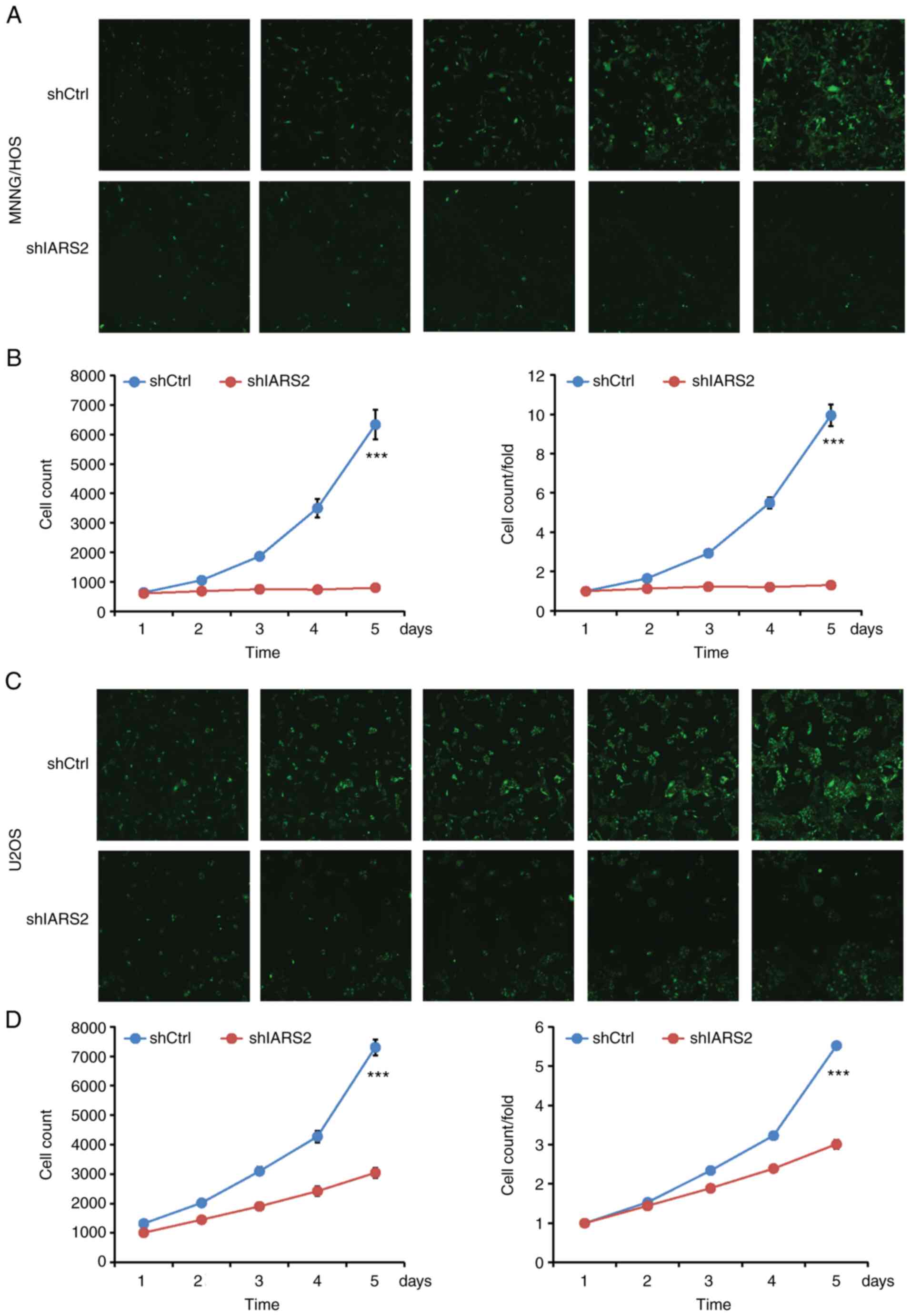|
1
|
Mirabello L, Troisi RJ and Savage SA:
Osteosarcoma incidence and survival rates from 1973 to 2004: Data
from the surveillance, epidemiology, and end results program.
Cancer Am Cancer Soc. 115:1531–1543. 2009.PubMed/NCBI
|
|
2
|
Sadykova LR, Ntekim AI, Muyangwa-Semenova
M, Rutland CS, Jeyapalan JN, Blatt N and Rizvanov AA: Epidemiology
and risk factors of osteosarcoma. Cancer Invest. 38:259–269. 2020.
View Article : Google Scholar : PubMed/NCBI
|
|
3
|
Lilienthal I and Herold N: Targeting
molecular mechanisms underlying treatment efficacy and resistance
in osteosarcoma: A review of current and future strategies. Int J
Mol Sci. 21:68852020. View Article : Google Scholar : PubMed/NCBI
|
|
4
|
Chen C, Xie L, Ren T, Huang Y, Xu J and
Guo W: Immunotherapy for osteosarcoma: Fundamental mechanism,
rationale, and recent breakthroughs. Cancer Lett. 500:1–10. 2021.
View Article : Google Scholar : PubMed/NCBI
|
|
5
|
Harrison DJ, Geller DS, Gill JD, Lewis VO
and Gorlick R: Current and future therapeutic approaches for
osteosarcoma. Expert Rev Anticancer Ther. 18:39–50. 2018.
View Article : Google Scholar : PubMed/NCBI
|
|
6
|
Yang C, Tian Y, Zhao F, Chen Z, Su P, Li Y
and Qian A: Bone microenvironment and osteosarcoma metastasis. Int
J Mol Sci. 21:69852020. View Article : Google Scholar : PubMed/NCBI
|
|
7
|
Yu YC, Han JM and Kim S: Aminoacyl-tRNA
synthetases and amino acid signaling. Biochim Biophys Acta Mol Cell
Res. 1868:1188892021. View Article : Google Scholar : PubMed/NCBI
|
|
8
|
Zhou Z, Sun B, Nie A, Yu D and Bian M:
Roles of Aminoacyl-tRNA synthetases in cancer. Front Cell Dev Biol.
8:5997652020. View Article : Google Scholar : PubMed/NCBI
|
|
9
|
Rajendran V, Kalita P, Shukla H, Kumar A
and Tripathi T: Aminoacyl-tRNA synthetases: Structure, function,
and drug discovery. Int J Biol Macromol. 111:400–414. 2018.
View Article : Google Scholar : PubMed/NCBI
|
|
10
|
Kim D, Kwon NH and Kim S: Association of
aminoacyl-tRNA synthetases with cancer. Top Curr Chem. 344:207–245.
2014. View Article : Google Scholar : PubMed/NCBI
|
|
11
|
Kim YW, Kwon C, Liu JL, Kim SH and Kim S:
Cancer association study of aminoacyl-tRNA synthetase signaling
network in glioblastoma. PLoS One. 7:e409602012. View Article : Google Scholar : PubMed/NCBI
|
|
12
|
Schwartzentruber J, Buhas D, Majewski J,
Sasarman F, Papillon-Cavanagh S, Thiffault I, Sheldon KM,
Massicotte C, Patry L, Simon M, et al: Mutation in the
nuclear-encoded mitochondrial isoleucyl-tRNA synthetase IARS2 in
patients with cataracts, growth hormone deficiency with short
stature, partial sensorineural deafness, and peripheral neuropathy
or with Leigh syndrome. Hum Mutat. 35:1285–1289. 2014.PubMed/NCBI
|
|
13
|
Mazaris P, Hong X, Altshuler D, Schultz L,
Poisson LM, Jain R, Mikkelsen T, Rosenblum M and Kalkanis S: Key
determinants of short-term and long-term glioblastoma survival: A
14-year retrospective study of patients from the Hermelin Brain
Tumor Center at Henry Ford Hospital. Clin Neurol Neurosurg.
120:103–112. 2014. View Article : Google Scholar : PubMed/NCBI
|
|
14
|
Yin J, Liu W, Li R, Liu J, Zhang Y, Tang W
and Wang K: IARS2 silencing induces non-small cell lung cancer
cells proliferation inhibition, cell cycle arrest and promotes cell
apoptosis. Neoplasma. 63:64–71. 2016. View Article : Google Scholar : PubMed/NCBI
|
|
15
|
Di X, Jin X, Ma H, Wang R, Cong S, Tian C,
Liu J, Zhao M, Li R and Wang K: The oncogene IARS2 promotes
non-small cell lung cancer tumorigenesis by activating the AKT/MTOR
Pathway. Front Oncol. 9:3932019. View Article : Google Scholar : PubMed/NCBI
|
|
16
|
Fang Z, Wang X, Yan Q, Zhang S and Li Y:
Knockdown of IARS2 suppressed growth of gastric cancer cells by
regulating the phosphorylation of cell cycle-related proteins. Mol
Cell Biochem. 443:93–100. 2018. View Article : Google Scholar : PubMed/NCBI
|
|
17
|
Livak KJ and Schmittgen TD: Analysis of
relative gene expression data using real-time quantitative PCR and
the 2(−Delta Delta C(T)) method. Methods. 25:402–408. 2001.
View Article : Google Scholar : PubMed/NCBI
|
|
18
|
Pistritto G, Trisciuoglio D, Ceci C,
Garufi A and D'Orazi G: Apoptosis as anticancer mechanism: function
and dysfunction of its modulators and targeted therapeutic
strategies. Aging (Albany NY). 8:603–619. 2016. View Article : Google Scholar : PubMed/NCBI
|
|
19
|
Li H, Tian Y, Li X, Wang B, Zhai D, Bai Y,
Dong C and Chao X: Knockdown of IARS2 inhibited proliferation of
acute myeloid leukemia cells by regulating p53/p21/PCNA/eIF4E
Pathway. Oncol Res. 27:673–680. 2019. View Article : Google Scholar : PubMed/NCBI
|
|
20
|
Zhong L, Zhang Y, Yang JY, Xiong LF, Shen
T, Sa YL, O'Yang YM, Zhao SH and Chen JY: Expression of IARS2 gene
in colon cancer and effect of its knockdown on biological behavior
of RKO cells. Int J Clin Exp Pathol. 8:12151–12159. 2015.PubMed/NCBI
|
|
21
|
Ma D, Li S, Nie X, Chen L, Chen N, Hou D,
Liu X and Gao B: RNAi-mediated IARS2 knockdown inhibits
proliferation and promotes apoptosis in human melanoma A375 cells.
Oncol Lett. 20:1093–1100. 2020. View Article : Google Scholar : PubMed/NCBI
|
|
22
|
Vona B, Maroofian R, Bellacchio E, Najafi
M, Thompson K, Alahmad A, He L, Ahangari N, Rad A, Shahrokhzadeh S,
et al: Expanding the clinical phenotype of IARS2-related
mitochondrial disease. BMC Med Genet. 19:1962018. View Article : Google Scholar : PubMed/NCBI
|
|
23
|
Hanahan D and Weinberg RA: Hallmarks of
cancer: The next generation. Cell. 144:646–674. 2011. View Article : Google Scholar : PubMed/NCBI
|
|
24
|
Burke PJ: Mitochondria, bioenergetics and
apoptosis in cancer. Trends Cancer. 3:857–870. 2017. View Article : Google Scholar : PubMed/NCBI
|
|
25
|
Ippolito L, Giannoni E, Chiarugi P and
Parri M: Mitochondrial Redox Hubs as Promising Targets for
Anticancer Therapy. Front Oncol. 10:2562020. View Article : Google Scholar : PubMed/NCBI
|















